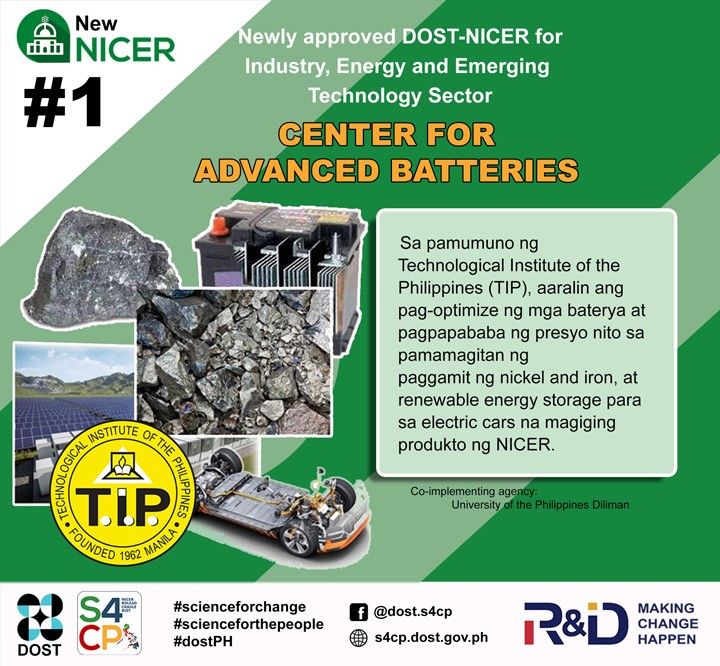
The Technological Institute of the Philippines (T.I.P.) is set to host the new Center for Advanced Batteries tasked to develop cheaper and longer life-cycle batteries for electric vehicles.
The T.I.P. center is one of the featured new Research & Development hubs under the Niche Centers for R&D in the Regions (NICER) program that the Department of Science and Technology (DOST) is putting up with host universities to build strong R&D capabilities in the regions.
The new NICER hub aims to develop economical lead-acid batteries with optimal performance capacity as better alternative energy storage to lithium-ion that can eventually be used for electric vehicles.
The virtual presser held last 8 October 2021 presented the various NICER programs that DOST is currently supporting including private school hubs in De La Salle University and Ateneo de Manila University. DOST had previously announced six other hubs in state universities led by the University of the Philippines.
DOST Undersecretary for Research and Development Rowena Cristina L. Guevara shared that these NICERS will allow the country’s academic and R&D institutions to upgrade their research facilities, develop policies, transfer technologies and ramp up regional initiatives and efforts towards a competitive innovation ecosystem.
“Through these R&D Centers,” added Guevara. “The DOST cultivates the innovation landscape in various sectors to ensure that no one is left behind in the R&D progress despite the setbacks brought by the COVID-19 pandemic.”
During the virtual presser, Dr. Drandreb Earl Juanico, the Program Leader of the Center for Advanced Batteries and Principal Researcher of CATALYST TechnoCoRe, Technological Institute of the Philippines, pointed out that the Center is now on its final stages of confirmatory laboratory results on the lead-acid battery improvements. He revealed that by December this year, “we will do a pilot-scale test at the Philippine Batteries Inc.’s factory in Bulacan.”
By April next year, Dr. Juanico’s group is hoping to have the initial batch of market-ready prototypes.
The Niche Center for Advanced Batteries likewise eyes to bridge the Renewable Energy (RE) infrastructure and wide-scale adoption to achieve sustainable energy initiatives for the country.
However, despite the purported positive environmental effects of using renewables in the country’s energy mix, the high capital cost especially on installation and energy storage, and energy inefficiency were perceived to be stumbling blocks to its complete roll-out.
Dr. Juanico, however, dispelled this by saying that if their study succeeds in prolonging the cycle life of the lead-acid battery by at least 25 percent, “its life cycle cost will be below that of lithium-ion batteries even if the price of these batteries declines by 8 percent annually (assuming the likes of Tesla and other lithium-ion battery manufacturers achieve economies of scale) from the year 2025 up to 2040.”
He estimated that the main contributor to this advantage is the lead-acid batteries’ high level of recyclability compared to lithium-ion batteries.
There are also future plans to develop electric vehicles running on lead-acid batteries through the eMobility NICER. The country has local manufacturing of lead-acid batteries and this will be used for the locally-developed electric vehicles, ranging from tricycles, jeepneys, and other modes of transport. “Localizing the advanced technologies that support lead-acid batteries will make our electric transport sector less dependent on imported lithium-ion batteries,” Dr. Juanico concluded.
Looking beyond possibilities, Dr. Juanico added that his team is eyeing to innovate the mature battery technology in consideration of its manufacturability. But they are also looking at reviving the nickel-iron battery using nanoscience and materials science.
They hope to add value to the nickel and iron ores extracted in the country through the improved lead-acid battery technology. He shared that the country is a leading nickel producer with well-established mines in Mindanao with an annual average production of 300 thousand metric tons since 2010. “In addition, the northern coast of Luzon has abundant offshore reserves of iron-ore sands at around 600 million metric tons,” added Dr. Juanico.
Similarly, the Center will look into new materials to develop components for future, portable battery products.
NICER is one of the various R&D programs under the Science for Change Program of DOST that was created to capacitate Higher Education Institutions in the regions to make significant improvements in regional research by integrating its development needs with the existing R&D capabilities and resources. It also provides institutional grants for HEIs in the regions for R&D capacity building to further improve their S&T infrastructure.
In total, there are currently 10 Centers under the NICER program, nine of which are the following: Center for Environmental Technologies and Compliance, Coastal Engineering Research (CoastER) Center, Smart Water Infrastructure and Management (SWIM) R&D Center, Center for Lakes Sustainable Development, Center for Sustainable Polymers R&D, Center for Vector of Diseases of Public Health, Integrated Protein Research and Development Center, Biomaterials for Diagnostics and Therapeutics Research and Development Center, and NeuRoTech.
Incidentally, the different NICER programs and projects were bannered last month at the virtual launch of the Big 21 in 2021 event of the DOST and these other R&D projects under the Science for Change Program and other innovations will also be showcased in the virtual celebration of the 2021 National Science and Technology Week (NSTW) to be held from 22-28 November 2021. For more details on the different activities, forums, and webinars for the 2021 NSTW, kindly visit its website at
https://ift.tt/3m7qeSJ.
Good News Pilipinas is celebrating its 15th Anniversary in 2021 by giving away prizes! Subscribe to this website and Good News Pilipinas! TV YouTube channel and enter the raffle by telling us what you like about our stories in an email to editor@goodnewspilipinas.com
The post Cheaper longer life-cycle batteries for e-vehicles for development at T.I.P. DOST R&D Center appeared first on Good News Pilipinas.
Source: Good News Pilipinas
0 Comments